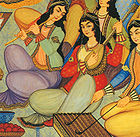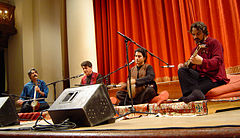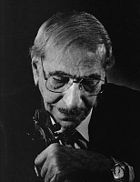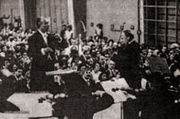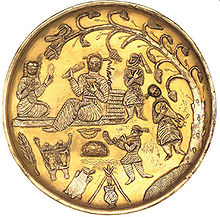- Music of Iran
-
Music of Iran 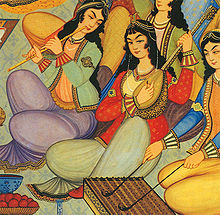
A historical painting from Hasht Behesht palace, Isfahan, Iran, from 1669.General topics Dastgah • Radif • Iranian musical instruments Genres Classical • Orchestra • Pop • Rock • Rap Specific forms Religious music Zoroastrian music • Sufism • Tazieh Traditional music Persian traditional music Regional music Local forms Mazandaran • Kermanshah • Khurasan Persian Music Central Asia The music of Iran has thousands of years of history, as seen in the archeological documents of Elam, one of the earliest world cultures,which was located in southwestern Iran. There is a distinction between the science of Music, or Musicology, which, as a branch of mathematics has always been held in high regards in Persia/Iran; as opposed to Music performance, (Tarab, Navakhteh, Tasneef, Taraneh or more recently Muzik), which has had an uneasy and often acrimonious relationship with the religious authorities and, in times of religious revival, with society as a whole.
The history of music construction in Iranian culture
 Taq-e Bostan carving, Women playing Chang (instrument) while the king is standing in a boat holding his bow and arrows, from 6th century Sassanid Iran.
Taq-e Bostan carving, Women playing Chang (instrument) while the king is standing in a boat holding his bow and arrows, from 6th century Sassanid Iran.
In ancient Persia musicians held socially respectable positions. We know that the Elamites and the Achemenians certainly made use of musicians but we do not know what that music was like. During the Parthian era, troubadours or Gosans were highly sought after as entertainers. There are theories[citation needed] in Academia that perhaps the early Dari Poets of Eastern Iran like Roudaki were in fact Gosans.
The history of musical performance in Sassanid Iran is however better documented than earlier periods. This is specially more evident in the context of Zoroastrian ritual.[1] By the time of Xusro Parviz the Sassanid royal court was the host of prominent musicians such as Ramtin, Bamshad, Nakisa, Azad, Sarkash, and Barbad. Among these survived names, Barbad is remembered in much documents and has been named as remarkably high skilled. He has been credited to have given an organisation of musical system consisting of seven "Royal modes" named Xosrovani, thirty derivated modes named lahn, and 360 melodies named dastan. These numbers are in accordance with Sassanid's calendar of number of days in a week, month, and year.[2] The theories these modal system were based on are not known, however the writers of later period have left a list of these modes and melodies. These names include some of epic forms such as kin-e Iraj (lit. the Vengeance of Iraj), kin-e siavash (lit. the Vengeance of Siavash), and Taxt-e Ardashir (lit. the Throne of Ardashir) and some connected with the glories of Sassanid royal court such as Bagh-e shirin (lit the garden of Shirin), Bagh-e Shahryar (lit. the Sovereign's Garden), and haft Ganj (lit. the seven threasures). There are also some of a descriptive nature like roshan cheragh (lit. bright lights).[2]
In general the period of Xosroparvis reign is regarded as an "golden age of Iranian music" and himself is shown in a large relief at Taq-e Bostan among his musicians and himself holding bow and arrows and while standing in a boat amidst a group of harpists. The relief depicts two boats and the whole picture shows these boats at "two successive moments within the same panel".[1]
Barbad may have invented the lute and the musical tradition that was to transform into the Maqam tradition and eventually the Dastgah music.
Even after Islam Persian Musicians did not disappear: Zaryab is often credited with being the greatest influence over Andalusian and Spanish music.[3] Farabi and Avicenna were not only musical theorist but adept at the lute and the Ney respectively.
Traditional Hierarchies of Authenticity and Value
The position of a particular work of music often depends on the music genre and its relationship to music theory. The academic Authentic Persian Music (Musiq-i-Asil) is strongly based on the theories of sonic aesthetics as expounded by the likes of Farabi and Shirazi in the early centuries of Islam. It also preserves melodic formula that are often attributed to the musicians of the Persian imperial court of Khosroe Parviz in the Sassanid Period. Dastgah is the music of those who have a greater share of, or affect to be in possession of, refined taste and high culture and as such, in spite of its present popularity, has always been the preserve of the elite. However, the influence of Dastgah can not be underestimated as it is seen as the reservoir of authenticity that other forms of musical genres derive melodic and performance ideas and inspiration.
Other genres of respectable music were not as soundly based in abstract theory, but from a utilitarian point of view were useful. To this group belongs the martial music of Persia (Musiqi Razmi), whose roots go back to the Parthian era, as attested by Roman sources. This form of music has now been almost completely replaced by European forms ever since the modernization of the armed forces. This type of music with large drums, brass and reed instruments was used not only at war but also in official and solemn occasions. The Naqareh Khaneh or the house of drum, the chief exponent of this type of music survived into the Qajar Period but by this time much of the expertise, fostered during the Safavid era, had disappeared. The only trace of this form of music in a much simplified form is the music of the Zurkhaneh, the traditional martial arts of Iran, where the exercises of champions (Pahlavan, literally Parthians) is regulated by a drummer / vocalist known as the Murshid.
Religious music as a category for music is not a musicologically homogeneous genre. The Shiite passion plays depicting the martyrdom of Imam Hussein have its beginnings in the martial music of Iran. Similarly Sufi music, though having set traditions of its own such as the use of the mystical instrument daf and a set compendium of librettos in Persian mystical poetry, is nevertheless perhaps closest to Dastgah music but enjoys a greater freedom of composition and is rhythmically more sophisticated.
The recitation of the Koran is not considered music by Muslims, but something more sublime. Similarly, religious liturgy or Noheh is a category of improvised song, but is never discussed in musical terms.
Popular music however occupies a low ebb in the rungs of respectability with the exception of folk music that plays an important role in the daily life of rural Iranians. Some of the most beautiful music composed in Iran is remembered in the folk songs in Kurdistan and Khorasan for example. Unlike other forms of music that derive from Classical Persian Music, Folk songs have greatly influenced the Dastgah system, and names such as Isfahan and Bayat e Turk attest to the regional origins of the melodic formulae that underlie Persian Art Musical Tradition.
Musical theatre in the form of Rohozi, whereby the covered pool in the middle of an inner courtyard served as a stage, is considered decadent by many Iranians. Tasneefs or popular urban compositions were often put together for the purposes of dance often in all women parties and some of the more famous compositions like Baba Karam and the accompanying dance is today the height of Persian Kitsch. (Dr Salardini - excerpt from upcoming book)
Persian Classical Music
Main article: Musiqi-e assil Persian National Music Society Orchestra conducted by Rouhollah Khaleghi with Gholam Hossein Banan on vocals
Persian National Music Society Orchestra conducted by Rouhollah Khaleghi with Gholam Hossein Banan on vocals
Persian classical music goes back a long way. Musicians like Barbod were legendary in the empire of the Sassanid era.
Until the early 20th century, musiqi-e assil was heard almost entirely at the royal courts of the monarchy. The Qajar dynasty ruled until 1925, with their influence declining since the turn of the century. Musiqi-e assil became a more common past-time for the next few decades, especially after cassettes were introduced in the 1960s. Before the 1979 revolution, Iran produced the Classic / Dastgahi singing stars Adib, Badie zadeh, Banan, Marzeyeh, Hoseyn Ghawami, Taj esfahani, and instrumentalists like Shahnazi , Abolhasan Saba, Asghar Bahari, Ahmad Ebadi, Hossein Tehrani, Faramarz Payvar, Ali Tadjvidi, Jalil Shahnaz and Hassan Kassai.
The years after the 1979 revolution emerged Islamic Republic approved stars like Parviz Meshkatian, Sodeyf Rambod, Hatam Askari Farahani, Jamshid Andalibi, Kayhan Kalhor, Mohammad Reza Lotfi, Hossein Alizadeh, Dariush Talai, Mohammad-Reza Shajarian, and Shahram Nazeri. The renaissance brought popularity to the genre. Even though the revolution era coincided with the music's popularity, music and Islam have not always meshed well, and many Iranian conservatives disliked even the simple melodies and lyrics of classical music. Women were banned from singing as soloists for male audience, though they were allowed to continue performing as soloists for female audience, as instrumentalists and in chorus.
Most notable living Iranian classical vocalists are: Sodeyf, Shajarian, Shahram Nazeri . Among relatively new classical vocalists we can name: Mohsen Keramati, Ali Jahandar, Homayoun Shajarian, Hamid Reza Nourbakhsh and Iraj Bastami.
More notable Iranian progressive musicians whom at their own time have created modern and contemporary Persian classical based theories and styles include the late Ostad Parviz Yahaghi, the late Ostad Asadollah Malek, the late Ostad Mohammad Baharloo, the late Ostad Alinaghi Vaziri, the late Ostad Varzandeh, the late Ostad Hossein Tehrani, Ostad Faramarz Payvar and Ostad Bahman Rajabi whom have impacted and influenced the classical Iranian traditions with their respective innovative musical approaches.
Notable bands:
- Hamavayan Ensemble
- Manoochehr Sadeghi: Santur
- Aref Ensemble
- Masters of Persian Music
- Zoufonoun Ensemble
- National music ensemble (Shahram Nazeri's group)
- Dastan ensemble: winner of Grand Prix du Disque for World Music
- Shams ensemble
- Kamkars ensemble
- Shakila's group: winner of Persian Academy Awards International
- Chemirani ensemble
- Lian ensemble
- Axiom of Choice band
- Chakavak Ensemble
- Bijan Vakili and Mehrbanou Goudarzi group
- Radif ensemble
- Nour ensemble
- Afsaneh music and dance group
Persian Symphonic Music
Sound file samples of classical Iranian music:

Persian Symphonic Music has a long history. In fact Opera originated from Persia much before its emergence in Europe. Iranians traditionally performed Tazeeieh, which in many respects resembles the European Opera.[4] The first serious pieces of Persian symphonic music have been composed by Gholma-Reza Minbashian, Gholam-Hossein Minbashian, Aminollah Hossein, Parviz Mahmoud and then Houshang Ostovar, Samin Baghtcheban, Emanuel Melik-Aslanian, Morteza Hannaneh, Hossein Nassehi, Hossein Dehlavi, Ahmad Pejman, Mohammad Taghi Massoudieh, etc.
There are also some growing attempts to combine Persian classical music and western classical music. Davood Azad, a renowned Iranian musician and vocalist, melded Johann Sebastian Bach's music style and Iranian classical music.
Iran's main orchestra include: National Orchestra, Tehran Symphony Orchestra and Melal Orchestra (Nations Orchestra).
Iran is not alien to western classical music either. Many radio stations in Tehran play Mozart's concertos on a daily basis, and many Iranians even make it to world fame and fortune. The 20th century classical composer Kaikhosru Shapurji Sorabji was of Iranian descent. The best examples of these Iranians are perhaps Shardad Rohani (LA Symphony Orchestra conductor), Lily Afshar (world class classical guitarist and student of Andrés Segovia), Loris Tjeknavorian(principal conductor to the Rudaki Opera House Orchestra in Tehran),[5] and Hormoz Farhat (Composer, Ethnomusicologist, Music Professor). In 2005, Ali Rahbari, the head of Tehran Symphony Orchestra, performed Beethoven's 9th Symphony in Tehran Vahdat Hall.[6]
Also in 2005, Perspolis Orchestra (Melal Orchestra) played a piece that dates back 3000 years. The notes of this piece of music, which is believed to have belonged to Sumerians and ancient Greeks, were discovered among some ancient inscriptions and after being deciphered by archaeologists, was orchestrated by Siavosh Beizaee for Perspolis Orchestra Symphony. However, as it is demonstrated on ancient reliefs of that era, the instrumentations of such pieces probably comprised wind instruments like horn and pipe. Renowned Iranian musician, Peyman Soltani, conducted the Perspolis orchestra.[7]
Folk music
Main article: Iranian folk music
The modal concepts in Persian folk music are directly linked with that of the classical music. However, improvisation plays a minor role as folk tunes are characterized by relatively clear-cut melodic and rhythmic properties. The function of each folk melody determines its mood. The varying aesthetic requirements of wedding songs, lullabies, love songs, harvest songs, dance pieces, etc., are met with transparent and appropriate simplicity. The majority of the classical instruments are too elaborate and difficult for the folk musicians. Instead, there are literally dozens of musical instruments of various sorts found among the rural people. In fact, each region of the country can boast instruments peculiar to itself. Three types of instruments, however, are common to all parts of the country. They are, a kind of shawm called Surnay (or Sorna ~ Zorna), the various types of Ney (flute), and the Dohol, a doubleheader drum.
Persian music includes a mixed Persian-Western music that functions as popular commercial music. The use of western popular rhythms, an elementary harmonic superimposition, and relatively large ensembles composed of mostly western instruments, characterize this music. The melodic and modal aspects of these compositions maintain basically Persian elements. On the whole, it would be something of an understatement to say that the artistic merit of such a melange as this is rather questionable.[8]
Iran is home to several ethnic groups, including Kurds, Azerbaijanis, Bakhtiari and Baluchi peoples. Turkmen epic poets similar to Central Asian musicians are common in Khorasan, while Kurdish music is known for its double-reed duduk and an earthy, dance-oriented sound. The most famous personalities in Iranian folk music are Pari Zangeneh and Sima Bina.
Music of Azarbaijan (Azerbaycan, Iran)
This is the music of provinces of Zanjan, East Azerbaijan, West Azerbaijan and Ardabil in Iran. Azerbaijan like other parts of Iran has a distinct music. On February 21, 1828, under the Treaty of Turkmenchay, Russia seized the control of Iranian territory to the North of the River Aras, which is now called the Republic of Azerbaijan where they share very similar music as Azarbijanis in Iran. The number of Azerbaijnis in Iran is about three times larger than population of Republic of Azerbaijan.
Kurdistan
The forms of music found in various parts of Kurdistan, all known as Kurdish music, vary depending on the climate and geography of the regions as well as their contact with the neighboring cultures. For example, the melodies found among the people living in the mountains are different from those found among the people living in the meadows. However, the poetry and the rhythms are common to both areas.
Kurdish music, similar to other Eastern music, is monophonic and modal (more specifically, based on the maqam system, which is loosely translated as modal). However, because multiple instruments with varying pitch range, color, and ornamentation capabilities are used to play the same melody, it is also heterophonic. In addition to` specifically Kurdish modes (maqams), Kurdish music also utilizes all the modes and dastgahs found in the traditional music of Iran.
There are two forms of Kurdish music. The first is based on the maqam system. Similar to traditional music of Iran, improvisation plays an important role in Kurdish music. While a maqam is used to designate a certain melodic structure, a musician may improvise within this structure by employing variations on ornamental figures, rhythms, and melodic forms. The maqams of Kurdistan, preserved by oral tradition throughout generations, are based on microtonal tuning systems where one can find intervals of half step, full step, three quarter step, and one and a quarter step. [These intervals are not necessarily in an equal-tempered 24 tone scale.]
The second form of Kurdish music is based on a set of melodies, known as gourani or closed, which have distinct and structured rhythms. The word gourani is derived from gabaran, which literally means "one who worships fire." This word is related to the ancient rituals of fire worship among the Zoroastrians. Through the passage of time gabaran was changed to gouran. Gourani is also the name of a tribe whose members speak Kurdish and are known for their poetry. The members of certain groups of dervishes (Ahle Hagh) in Kermanshah and certain regions of Sanandaj, use this word to refer to the songs performed during their spiritual ceremonies. Because of its distinct rhythm, gourani is often accompanied by other instruments, and in some cases by clapping.
The poems used in most Kurdish music are filled with stories of romance and unrequited love. These poems have often two verses, which are divided in ten, eleven, or twelve syllables, and are based on the Gathas of the Zoroastrians. Kurdish melodies are very simple; their range is usually confined to a few notes. The form of the music is often strophic, and every gourani has a particular melody that is sung with various stanzas. At the end of every stanza the strophe is repeated unchanged throughout the song. Every gourani is characterized by a specific strophe. Similar to a lied or a chanson, gouranis may be accompanied by instrumental sections, which have three parts: prelude, middle section, and the ending. The prelude and the ending are performed by the group, and the middle section is performed in the form of call and response.
Gouranis fall into several categories, each performed with specific melodies for specific occasions. Some examples are work gouranis, shepherd gouranis, romantic gouranis, religious and spiritual gouranis, festive gouranis, Chemari (mourning) gouranis, war gouranis, children gouranis, women gouranis, and Ramadan gouranis.
Before Islam, the "religious and spiritual gouranis" were used by the Kurds in their worship rituals of Ahura Mazda (the wise and supreme god of Zoroastrianism), fire, the sun, and the moon. Within Islam, new gouranis were developed for worship of God and paying tribute to sacred figures. The dervish houre, Azan (special forms of reciting of the Koran), and zekr [also a ritualistic dance performed by the dervishes during devotional ceremonies] are among these types of gouranis. The "festive gouranis," which have strong and exciting rhythms, are used for marriage, circumcision, or holiday celebrations, and are often accompanied by dancing and clapping. The "war gouranis" have moving rhythms, and are often used with poems that induce feelings of nationalism and protection of freedom. "Children gouranis" have simple rhythms and accompany children's poems. "Women gouranis" are sung by women during their everyday chores, such as milking the cows, carrying water from the springs, or picking flowers. "Chemari gouranis," which are sung in the funerals while carrying the dead (especially a young deceased), are accompanied by sorna (a wind instrument) and dohol (a large percussion instrument), and have very sad poems. "Ramadan gouranis" are mostly used during the month of Ramadan to declare the coming of dawn [when people have food before fasting during the day]. Accompanied by sorna and dohol, they are played in elevated regions of cities and villages. (H. Kamkar - master musician www.kereshmeh.com)
Khorasan
Due to its ethnic diversity and the existence of different languages and religious observations (Sunni and Shi'a), the musical tradition of Khorasan is very rich. From the north to the south, the music scene varies greatly. In the north of Khorasan, one can find the bakhshi narrating and singing, among other things, "daastans" (stories in old Persian), although they can also sing in Kurdish about the historical deeds of local figures. They accompany themselves on the dotar. A leading exponent of this type is the late Haj Ghorban Soleimani. One can also find in the north, the Asheq who play "dohol" (double-faced drum), the "sorna" (a kind of oboe-like reed instrument) and the "qoshme" (double clarinet made of the central nervure of the plumage of birds tied together). The Asheq are specifically associated with the Kurds and play at wedding dances and village feasts. In the East of Khorasan, near Torbat Jam, the main instrument is the dotar with some modifications,[9] but there are no Bakhshi and the music is different. Here, the music takes the form of "ghazal khani'" and is performed by singers of quatrains and "ghazals" - lyric poems based on the invocations of mystic poets like Rumi, Attar and Sheikh Ahmad Jami. Purely instrumental pieces also figure in the repertoire.
More towards the south, in the regions of Birjand and Qa'in, the musical culture changes again: the dotar is no longer present (although it seems that in the past, it was played). The songs are called "sotak" and are accompanied on the "dayereh" (tambourine). (Ameneh Yousefzadeh - Musicologist)[10]
Turkmen Music
In Golestan and Khorasan in Iran as in Turkmenistan and Uzbekistan, the word bakhshi means instrumentalist, singer, and storyteller. The word bakhshi comes from Turkish, and in turn from a Chinese word, po-shih, meaning erudite. Through the Turkish Ouigours, certain Chinese language elements infiltrated 13th and 14th century Mongol literature. The word bakhshi appeared in Turkmen, Iranian and Turkish literature with the advent of the Mongols. At the time, the role of the bakhshi seems to have been sometimes that of the healing shaman, and at other times that of a Buddhist priest.
As for the bakhshi of Khorasan, they claim that the origin of their name can be found in the word bakhshande (donor, bestower of gifts) because of the musical gift that God has bestowed upon them. This is a title of respect in northern Khorasan and among the Turkmen of Torkaman-Sahra.
The bakhshi can also be found in almost all of Central Asia, among the Kazakh, Kirghiz, Uzbek, and Turkmen people as well as in Afghanistan, Tajik-Arab and in Xinjiang. Among other ethnicities, on the other hand, the term bakhshi, throughout centuries has designated a bard, a story-teller, and singer of legends and epics.
As a singer, the bakhshi is more precisely a narrator of dastan (story) and an instrumentalist who plays the dotar (long-necked two-stringed instrument) and who, in most cases, fabricates his own musical instrument. The majority of the great bards of Khorasan, regardless of their ethnic origin, sing in three languages (Turkish, Persian, and Kurdish). Whether professional or semi-professional, nowadays the bard doesn't usually earn his living solely through playing music. Most often, he is also, for example, a farmer, a barber, or a teacher. With his instrument, the dotar, he usually sings and plays by himself. However, the Turkmen bards prefer to play in groups of two or three. In this case, the bard is accompanied by another dotar player and a person playing the kamanche. The right to assume the title of bakhshi is subject to specific conditions. A bakhshi should not only be a good musician and have a good voice, he also needs excellent diction for telling stories. Ideally, he learns his art from his father or his uncle while living under the family roof. Some acquire their apprenticeship under the tutelage of a master (ostad). The learning process evolves in three stages: 1) learning the dotar technique, 2) learning vocal techniques, 3) memorizing the stories. In the last stage, the master teaches his student a fragment of a dastan on a daily basis, so that he can memorize and recite it the next day. The bakhshi is renowned for his prodigious memory.
Traditionally, the bakhshi plays at village ceremonies such as weddings and circumcisions, but he also performs at private gatherings and in ghahve-khanes (coffee houses) of the bazars. Unfortunately, nowadays, television has taken the place of the traditional bard in the Ghahve-khane. Fortunately, today we can also hear the bakhshi performing in concerts often within the context of festivals (Ameneh Yousefzadeh).
Mazandaran
Mazandaran has a diverse folk music culture that includes songs and instrumental and ritual music. Rhythm is usually simple in songs, which include katuli, which is most common around the town of Aliabad-e Katul; the song is sometimes said to be sung when people take a catouli cow out to graze. Because the song was originally sung while walking and working, it often has syllables like jana, hey or aye added, to allow the singer to breath while working (a work song). Another kind of song is called kaleh haal (or kal kaal or Leili's lover). The term kaleh haal may refer to its shortness of length (kale haal means short present) or to its common wingers, housewives who sang it while cooking with a kaleh, a type of oven. Amiri songs usually use long poems written by Amir Pazevari, a legendary poet from Mazandaran.
A type of song called najma describes the love between Prince Najmedin of the Fars area and a girl named Ranaa. The najma is popular throughout Iran, adapted for the local cultures. The Charvadars are an ancient class of merchants who sold commodities abroad for a local village; their songs are called charvadari. In contrast to most Mazandarani music, charvadari has a prominent rhythm, which may be because it was often sung on horseback.
Traditional music of women
This music is a special type of folk music. Maryam Akhondy, a classical singer, collected such songs and published them on her album "Banu - Songs of Persian Women". It had been sung at the cradle, at the housework and work in the fields or on women's celebrations.
Pop music
Iran developed its own pop music by the 1950s,when Vigen introduced the Guitar for the first time and later on using indigenous instruments and forms and adding electric guitar and other imported characteristics. He became the most popular pop singer of this period for his unique voice. Later on in 1970's, Googoosh who was Vigen's student became popular. After the Iranian Revolution in 1979, pop music's future seemed dark because of the new Islamic laws and restrictions. Many Iranians migrated to foreign countries, especially Los Angeles in the United States, and Iranian-in-exile pop stars include: Dariush Eghbali, Ebi, Siavash Shams, Siavash Ghomeyshi, Hayedeh, Homeira, Mahasti, Hassan Sattar, Shohreh Solati, Shahram Solati, Noshafarin, Aref, Shahram Shabpareh, Layla Forouhar, Faramarz Asef, Andy, Koros, Martik, Morteza, Farzaneh Ahmad Azad, Mansour, Shahram K, Fattaneh, Moein, Hasan Shamaeezadeh, Nazi Afshar, Bijan Mortazavi,
Artists Inside Iran
Arian Band, Barobax
Iranian rock and Metal music
Rock music in Iran has been influenced by many traditional forms of Iranian music and popular Western rock bands such as Pink Floyd, The Doors, Dire Straits, AC/DC, Metallica and Pantera. Iranian rock music first developed in the 1970s, but was largely silent during the 1980s, only to witness a recurrence in the 1990s. One of the notable Heavy metal bands is Angband which is believed to be the first Iranian metal act to release its work internationally through a European label. [11]
Renowned personalities
- 127
- Agah Bahari
- Angband
- Kiosk
- Hypernova
- Mohsen Namjoo
- The Yellow Dogs Band
Iranian hip hop and Rap music
Main article: Persian RapThe term hip hop refers to a musical and political movement that has developed predominantly over the last quarter-century. Since first emerging in New York City in the seventies, hip-hop has grown to encompass not just music, but an entire lifestyle that consistently incorporates diverse elements of ethnicity, technology and urban life. Iranians gen Xr's have mixed elements of the new and the old to create a new chapter in the "Music of Iran".
- Shahin Najafi
- Hichkas
- Erfan
- Salome
Electronic music
Inspired by some of the most significant artists of the genre Karlheinz Stockhausen, John Cage, David Tudor, Gordon Mumma and Iannis Xenakis who performed in Shiraz Arts Festival, but after the Iranian Revolution in 1979, faced dark future like most of the other genres. Many of the expatriate Iranians in North America and Europe are involved in electronic music. The best known group is the Washington, D.C.-based Deep Dish, which consists of Ali "Dubfire" and Shahram.
Renowned personalities
- Deep Dish: (Ali "Dubfire" Shirazi and Shahram Tayebi) Washington DC, USA
- Low End Specialists (New York City) -The Low End Specialists are NYC based duo Mac Clark and Ali Geramian.[dubious ]
- Omid 16b (Omid Nourizadeh), London, UK
- DJ Aligator, Denmark
Iranian children music
Iranian children music has commonly simple melodies and lyrics and are performed by kids.
Iranian music in other countries
Iranian music style has influenced the music of the Caucasus and Central Asia.
Songs
See also
- List of Iranian musicians
- Shiraz Arts Festival
International recognition of Iranian music
Music of Iran and Iranian musicians have received countless awards in the course of history. Here are some:
2008
- Loris Tjeknavorian: Austria's Cross of Honor for Science and Art First Class (2008)
2007
- Asia Society has awarded Shahram Nazeri by the prestigious Lifetime Cultural Heritage Award along with Secretary General of United Nations on Nov 2007
- Mozart Medal, Mohammad Reza Shajarian.[12]
- Légion d'honneur, Shahram Nazeri.
- Grammy Award (nomination), Endless Vision, and Hossein Alizadeh.
2006
- Grammy Award (nomination), Faryad album, Masters of Persian Music.
- Grammy Award, Ali Shirazinia, Shahram Tayyebi and Deep Dish.
- Grammy Award for Best Orchestral Performance (nomination), Persian Trilogy by Behzad Ranjbaran.
- "Best Middle Eastern Song" & "Best Middle Eastern Album", 2006 JPF Awards: Andy Madadian.
- "2006 Best International Armenian Album Award" for the 2006 Armenian Music Awards: City of Angels by Andy Madadian.
- 3 tan band. J.F.K Awards 2006 For Best eastern rock song "A Drop Of Alcohol"
- Golden Lioness Award for Best Conductor, The World Academy of Arts, Literature, and Media: Ali Rahbari.
- Golden Lioness Award for Classic Music Best Soprano Performer, The World Academy of Arts, Literature, and Media: Monika Jalili.
2005
- Golden Lioness Award for Classical-Best Vocal Ability, The World Academy of Arts, Literature, and Media:
Akbar Golpa
- Golden Lioness Award for Classical-Arrange & Pop, The World Academy of Arts, Literature, and Media:
Hassan Sattar
- Golden Lioness Award for Best Instrumentalist, The World Academy of Arts, Literature, and Media:
Muhammad Heidari
- Golden Lioness Award for Classic-pop, The World Academy of Arts, Literature, and Media:
Mahasti
- Golden Lioness Award for Classical Performance, The World Academy of Arts, Literature, and Media:
Hooshmand Aghili
- Golden Lioness Award for Classical Performance, The World Academy of Arts, Literature, and Media: Shakila.
- UNESCO music award (Picasso award), nominee: Mohammad Reza Darvishi.
- "Best Unsigned U.K. Hip Hop Artist, Riddla:
2003
- Grand Prix du Disque for World Music, Dastan ensemble and Parisa.
- BBC Awards for World Music, Kayhan Kalhor.
2001
- NAV’s best contemporary world music album: Axiom of Choice (band).
- Best Recombinant World Music Ensemble in 2001 by the LA Weekly Music Awards. (nomination): Axiom of choice band.
2000
- Orville H. Gibson Award, Lily Afshar.
1999
- Picasso Medal, Mohammad Reza Shajarian.
- Pikanes award, Thailand's most prestigious music award for an outstanding orchestral performance: Shahrdad Rohani.
1977
- Prestigious Gold Medal at the Besançon International Conductors' Competition, Ali Rahbari.
- Silver medal in Geneva International Conducting Competition, Ali Rahbari.
Others
- Rudolf Nissim Award, Behzad Ranjbaran.
- Grand Prize in the Aspen Music Festival Guitar Competition, Lily Afshar.
- Top Prize in the Guitar Foundation of America Competition, Lily Afshar.
- Loris Tjeknavorian, Homayoon Order and Medal for the composition of "Son et Lumiere Persepolis 2500"
Sources and Further reading
- Akbarzadeh, Pejman. Persian Musicians, Navid Publications, Shiraz, 1998, ISBN 964-6810-20-9.
- Akbarzadeh, Pejman. Persian Musicianof the people Roshanak Publications, Tehran, 2002, ISBN 964-93867-3-4.
- During, Jean and Mirabdolbaghi, Zia, "The Art of Persian Music", Mage Pub; 1st edition (Book & CD) June 1, 1991, ISBN 978-0-934211-22-2
- Nelly Caron and Dariush Safvate, "Iran: Traditions Musicales" (Paris, 1966).
- Nooshin, Laudan. "The Art of Ornament". 2000. In Broughton, Simon and Ellingham, Mark with McConnachie, James and Duane, Orla (Ed.), World Music, Vol. 1: Africa, Europe and the Middle East, pp 355–362. Rough Guides Ltd, Penguin Books. ISBN 1-85828-636-0.
- Nettl, Bruno (1989). Blackfoot Musical Thought: Comparative Perspectives. Ohio: The Kent State University Press. ISBN 0-87338-370-2.
- Ameneh Youssefzadeh, "Iran’s Regional Musical Traditions in the Twentieth Century: A Historical Overview." Iranian Studies, volume 38, number 3, September 2005. Metapress.com.
- DVD of TOMBAK / Madjid Khaladj - Coproduction: Le Salon de Musique & Ecole de Tombak | Language : français, anglais, espagnol | 172 minutes | Booklet of 80 pages (French/English.)| EDV 937 CV. CD Infinite Breath / Madjid Khaladj, NAFAS / Bâ Music Records.
Notes
- ^ a b (Lawergren 2009) iv. First millennium C.E. (1) Sasanian music, 224-651.
- ^ a b (Farhat2004) p. 3.
- ^ Iranian.com
- ^ Iranian performance of Beethoven's 9th Symphony (BBC Persian)
- ^ Loristjeknavorian.com
- ^ BBC.co.uk
- ^ 3000 Year Old Piece to be Performed at Persepolis
- ^ Prof. Farhat-musicologist Persianartmusic.com
- ^ Torbatjam.com
- ^ Kereshmeh.com
- ^ Blabbermouth link August 2010
- ^ Maestro Shajarian was awarded the Mozart Medal.(2007)
- Farhat, Hormoz (2004). The Dastgah Concept in Persian Music. Cambridge University Press. ISBN 0521542065.
- Lawergren, Bo (2009). "Music in Iranian land, history. i. Pre-Islamic Iran". Encyclopaedia Iranica. http://www.iranica.com/newsite/articles/unicode/ot_grp15/ot_music_history_i_20090220.html.
External links
- BBC Radio 3 Audio (60 minutes): Iranian classical music - Kayhan Kahor. Accessed November 25, 2010.
- BBC Radio 3 Audio (60 minutes): Khorosan to Kurdistan. Accessed November 25, 2010.
- BBC Radio 3 Audio (105 minutes): Musical life in Iran. Accessed November 25, 2010.
- Audio clips - traditional music of Persia. French National Library. Accessed November 25, 2010.
- Iranian music at the Open Directory Project
Middle Eastern music By style Al Jeel · Arabesk · Arabic pop · Ashiq music · Bedouin · Classical Arab · Coptic · Iranian folk · Khaliji · Laïka · Mizrahi · Meykhana · Mugham · Ottoman classical · Persian pop · Persian traditional · Qawwali · Samri · Sawt · Sharki · Tsifteteli · Turkish folk
By region Afghanistan · Arabic · Azerbaijani · Bahrain · Cypriot · Djibouti · Egyptian · Eritrea · Iraqi (Assyrian) · Israel · Jordanian · Kurdish · Kuwait · Lebanese · Oman · Palestinian · Persian · Qatar · Saudi Arabian · Somalia · Sudan · Syrian · Turkish · Yemen · United Arab Emirates
Related topics Arabic hip hop · Arabic maqam · Aylugis Gorav · Azerbaijani hip hop · Dabke · Dastgah · Egyptian hip hop · Halay · Iqa' · Iranian hip hop · Israeli hip hop · Kanto · Maqam al-iraqi · Makam · Middle Eastern dance · Middle Eastern hip hop · Muzika Mizrachit · Palestinian hip hop · Pop folk · R'n'Besk · Rapbesk · Tallava · Usul
Music of Asia Sovereign
states- Afghanistan
- Armenia
- Azerbaijan
- Bahrain
- Bangladesh
- Bhutan
- Brunei
- Burma (Myanmar)
- Cambodia
- People's Republic of China
- Cyprus
- East Timor (Timor-Leste)
- Egypt
- Georgia
- India
- Indonesia
- Iran
- Iraq
- Israel
- Japan
- Jordan
- Kazakhstan
- North Korea
- South Korea
- Kuwait
- Kyrgyzstan
- Laos
- Lebanon
- Malaysia
- Maldives
- Mongolia
- Nepal
- Oman
- Pakistan
- Philippines
- Qatar
- Russia
- Saudi Arabia
- Singapore
- Sri Lanka
- Syria
- Tajikistan
- Thailand
- Turkey
- Turkmenistan
- United Arab Emirates
- Uzbekistan
- Vietnam
- Yemen
States with limited
recognition- Abkhazia
- Nagorno-Karabakh
- Northern Cyprus
- Palestine
- Republic of China (Taiwan)
- South Ossetia
Dependencies and
other territoriesCategories:- Tyler music
- Iranian music
- Iranian culture
Wikimedia Foundation. 2010.


